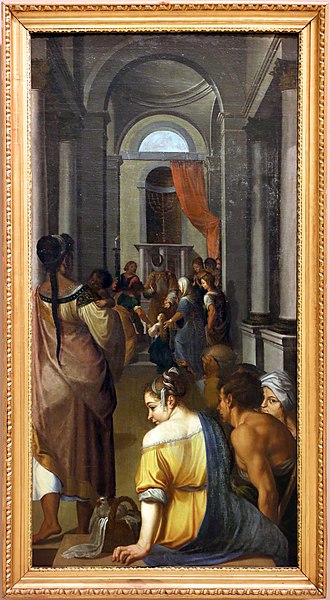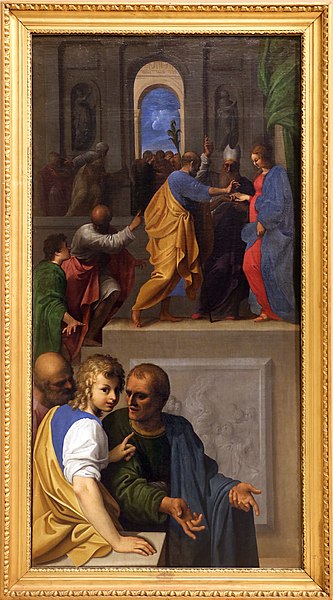Cesare left Ferrara for Modena, the new capital of his Duchy, in 1598. The city was not ready to host such a refined and numerous court, so the castle was quickly renovated to make it habitable and only a few years later began the decorations and embellishment of the place.
Cesare, with a strong religious sentiment, wanted a chapel next to his private flat, the work on which was completed on the day dedicated to the Nativity of the Virgin to whom the sacred place was dedicated (8 September 1602). The Marian theme was to have been developed on the altarpiece and in other paintings, which were, however, not present at the time of the inauguration. Cesare had in fact commissioned the works from Annibale Caracci and Caravaggio, but they did not carry out the Duke’s request and it was only after a long time that Cesare was convinced to involve local artists who were certainly more reliable. Thus, the altarpiece was commissioned to Scarsellino, while two other canvases to Ercole dell’Abate and Bartolomeo Schedoni. The paintings illustrate three episodes from the life of the Virgin and, although developed in an uncoordinated manner and at different times by the three artists, the triptych is dynamic and of excellent pictorial quality.
The ‘Nativity of the Virgin’ painted by Scarsellino in 1607 presents a highly theatrical narrative structure, highlighted by the skilful play of light and shadow. The centrepiece of the painting is the little baby girl, raised to heaven from the arms of her parents Saint Anne and Joachim. From a dense cloud crowded with cherubs emerges God the Father to rejoice at the birth of the future Mother of Christ. Around the sacred episode only female figures move, busy with various birth-related activities: on the left, the woman in the foreground carries a cradle, behind another carries an amphora, while in the foreground a woman from behind leans on a wooden basin. The figure on the right, also from the back, is preparing to open the green curtain of the canopy on which Saint Anne is lying. In the lower part of the painting, the predominant colours are blue and yellow that emerge vigorously from the dark background creating a strong contrast to the upper part where dark tones prevail.
On either side of the lower entrance were two paintings, the “Marriage of the Virgin” and the “Presentation at the Temple”, both set in a complex architectural interior where the central episode is relegated to the background, using characters in the foreground as backdrops. In the first work, painted by Schedoni, the religious scene takes place at the top of a staircase; the painter skilfully arranges the characters around the central scene so as to facilitate the viewer’s gaze. In the foreground we find a young man with his back turned to look out of the painting, inviting us to enter into the conversation he is having with two elderly men, while behind, two men are climbing the stairs, accompanying us to the fulcrum of the representation. The background is decorated by imposing architecture crowded with people intent on witnessing the event. The ‘Presentation of the Virgin at the Temple’ has a similar structure to the previous painting, in fact the foreground is occupied by the figure of a young woman seated with her back turned towards the spectator, next to her is a basket with a dove. The interior is marked by columns that lead the eye to the semicircular apse where, in front, the sacred episode takes place. The figures huddling around the Virgin and the Priest show a quicker touch than those painted in the foreground.
The three paintings that decorated Cesare’s chapel are a precious testimony of early 17th century Po Valley painting that can still be admired today in the collections of the Galleria Estense.









